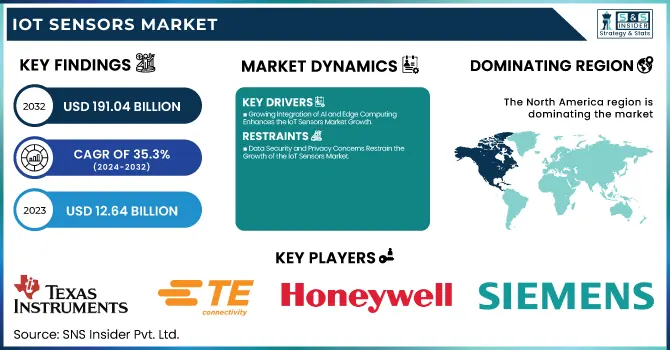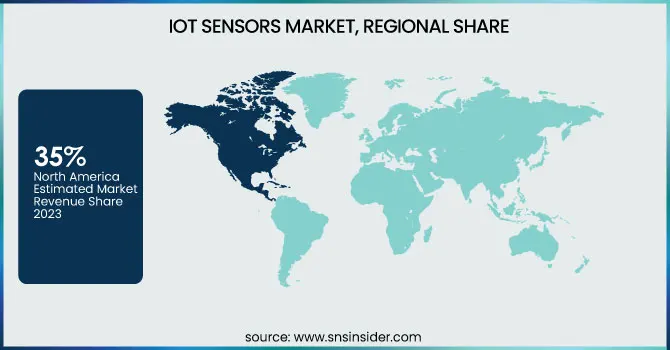IoT Sensors Market Size & Growth:
The IoT Sensors Market Size was valued at USD 12.64 Billion in 2023 and is expected to reach USD 191.04 Billion by 2032 and grow at a CAGR of 35.3% over the forecast period 2024-2032. The market is growing rapidly, driven by the adoption of smart technologies across industries such as healthcare, automotive, industrial automation, and smart homes. IoT sensors enable real-time monitoring, automation, and data-driven decision-making, fueled by AI, 5G, and edge computing advancements.

To Get more information on IoT Sensors Market - Request Free Sample Report
Key growth factors include rising demand for real-time solutions, sensor miniaturization, and Industry 4.0 investments, while data security, high costs, and interoperability remain challenges. The market is shifting toward wireless, battery-operated, and AI-powered sensors, with sustainability and regulatory compliance shaping innovation. As industries embrace digitalization, the IoT sensors market presents vast opportunities for R&D, new products, and strategic collaborations.
IoT Sensors Market Dynamics
Key Drivers:
-
Growing Integration of AI and Edge Computing Enhances the IoT Sensors Market Growth
The increasing integration of AI and edge computing in IoT sensors is a major driver fueling market growth. AI-powered sensors enable real-time data analysis, predictive maintenance, and automation, reducing latency and improving efficiency across industries like smart homes, healthcare, and industrial automation. Edge computing further enhances sensor capabilities by processing data locally, minimizing the need for cloud dependency and enabling faster decision-making.
These technologies optimize energy consumption and improve security by reducing data transmission vulnerabilities. Industries leveraging AI-driven IoT sensors benefit from enhanced operational efficiency, reduced downtime, and lower maintenance costs. With 5G connectivity and advanced machine learning algorithms, AI-integrated IoT sensors are expected to revolutionize applications such as autonomous vehicles, smart cities, and precision agriculture. This trend is driving significant investments in R&D, making AI and edge computing a key growth accelerator for the IoT sensors market.
Restrain:
-
Data Security and Privacy Concerns Restrain the Growth of the IoT Sensors Market
Data security and privacy issues are significant restraints in the IoT sensors market, limiting their widespread adoption across industries. IoT sensors collect and transmit vast amounts of sensitive data, including personal, industrial, and medical information, making them prime targets for cyberattacks and unauthorized access. The lack of standardized security protocols across different IoT ecosystems increases vulnerabilities, leading to potential data breaches, hacking, and compliance risks. Many organizations hesitate to adopt IoT sensors due to concerns about data integrity, regulatory compliance (such as GDPR), and consumer trust.
Additionally, end-to-end encryption, authentication mechanisms, and secure firmware updates require continuous advancements, adding to implementation costs. Governments and regulatory bodies are enforcing strict cybersecurity measures, but businesses must invest in robust security frameworks, blockchain-based authentication, and AI-driven threat detection to mitigate risks. Addressing data security challenges is crucial to sustaining market growth and ensuring widespread IoT sensor adoption.
Opportunities:
-
Rising Adoption of Smart Cities and Infrastructure Development Creates Opportunities in the IoT Sensors Market
The rapid development of smart cities and infrastructure projects presents a significant opportunity for IoT sensor adoption. Governments and urban planners are leveraging IoT sensors to enable real-time monitoring, automation, and data-driven decision-making in sectors like traffic management, energy efficiency, waste management, and public safety. IoT sensors integrated with AI, cloud computing, and 5G networks are revolutionizing city operations, improving efficiency, sustainability, and connectivity.
Additionally, IoT-enabled surveillance systems and environmental monitoring sensors enhance urban security and sustainability. Governments worldwide are investing in smart infrastructure initiatives, creating a massive demand for scalable, low-power, and wireless IoT sensors. As cities move toward digital transformation, IoT sensor manufacturers have opportunities to collaborate with municipal bodies and tech firms, driving market expansion.
Challenges:
-
High Deployment and Maintenance Costs Pose Challenges to IoT Sensors Market Expansion
The high cost of deploying and maintaining IoT sensors remains a major challenge in market growth. IoT sensor integration requires advanced hardware, software platforms, and network infrastructure, making initial setup costly, especially for small and medium-sized enterprises (SMEs). The complexity of IoT sensor ecosystems necessitates continuous updates, firmware upgrades, and cybersecurity enhancements, leading to recurring expenses.
Additionally, sensor maintenance in harsh environments such as industrial sites, oil & gas fields, and remote locations is costly and labour-intensive. Limited battery life, calibration needs, and sensor replacement add to the financial burden. Many organizations struggle with interoperability issues due to diverse IoT protocols, increasing the cost of integration with existing systems. To overcome these challenges, manufacturers are focusing on energy-efficient designs, low-cost sensors, and AI-driven predictive maintenance solutions. However, reducing deployment costs remains critical for wider adoption across industries.
IoT Sensors Market Segments Overview
By Type
The motion sensors segment led the IoT sensors market in 2023, accounting for 37% of total revenue, driven by increasing adoption in smart homes, industrial automation, automotive safety, and healthcare applications. Motion sensors, including accelerometers, gyroscopes, and infrared sensors, enable precise object detection, movement tracking, and security enhancements. Companies like STMicroelectronics, Bosch, and Murata Manufacturing have launched advanced motion sensors to meet the growing demand. The rise of AI-powered IoT motion sensors is revolutionizing automation, enabling predictive maintenance, smart surveillance, and autonomous navigation. With the expansion of Industry 4.0 and smart infrastructure, motion sensors will remain crucial in enhancing efficiency, security, and user experiences, further solidifying their market dominance.
The light sensors segment is experiencing the fastest growth in the IoT sensors market, projected at a CAGR of 36.8% during the forecast period. Increasing integration of ambient light sensors, photodetectors, and proximity sensors in smart lighting, automotive, and environmental monitoring is fueling demand.
Meanwhile, Analog Devices launched an AI-powered optical sensor, enabling energy-efficient smart lighting and automation. The rise of connected devices, smart cities, and sustainable energy solutions is further boosting adoption. In the automotive sector, NXP Semiconductor’s light sensors enhance adaptive headlights and driver-assist systems. IoT-enabled light sensors are revolutionizing energy conservation and smart infrastructure, playing a key role in automated lighting control, daylight harvesting, and environmental sensing. With rising demand for energy-efficient and adaptive technologies, light sensors are becoming essential in next-generation IoT ecosystems.
By End-Use
The consumer electronics segment led the IoT sensors market in 2023, driven by the growing demand for smartphones, wearables, smart home devices, and connected appliances. IoT sensors play a critical role in enhancing user experience, automation, and energy efficiency in consumer devices. Leading companies have been actively launching innovative sensor-based products to meet rising demand.
Additionally, Murata and Bosch Sensortec have developed MEMS motion sensors and environmental sensors, widely used in wearables and smart home devices. The expansion of 5G, AI-powered assistants, and connected ecosystems is accelerating IoT sensor adoption in consumer electronics. As demand for smart, automated, and energy-efficient devices grows, IoT sensors will continue to drive innovation, solidifying this segment’s dominant position in the market.
The automotive & transportation segment is the fastest-growing sector in the IoT sensors market, projected to expand during the forecast period 2024-2032. The rise of autonomous vehicles, advanced driver-assistance systems (ADAS), and connected mobility solutions is fueling demand for IoT sensors in this sector. Companies are launching innovative sensor technologies to enhance vehicle safety, navigation, and efficiency. The increasing adoption of V2X (Vehicle-to-Everything) communication, fleet telematics, and predictive maintenance is further accelerating IoT sensor deployment. As the industry shifts toward electric and autonomous mobility, IoT sensors will be crucial in enhancing safety, reducing emissions, and enabling smart transportation networks, driving rapid growth in this segment.
IoT Sensors Market Regional Outlook
North America held the largest share in the IoT sensors market in 2023, accounting for an estimated 35% of total revenue, driven by high adoption of smart technologies, strong IoT infrastructure, and significant R&D investments. The region's leadership is fueled by advancements in smart homes, industrial automation, connected healthcare, and automotive IoT. Companies like Texas Instruments, Honeywell, and Analog Devices are actively innovating sensor technologies to meet rising demand.
Additionally, General Electric (GE) has integrated predictive maintenance IoT sensors into industrial machinery, optimizing performance and reducing downtime. The growing adoption of 5G, AI-driven analytics, and cloud-based IoT platforms in North America has further accelerated sensor deployment. With continuous advancements in IoT security, edge computing, and connected ecosystems, North America is expected to maintain its dominance in the IoT sensors market.
Asia Pacific is the fastest-growing region in the IoT sensors market, projected to expand at a CAGR of over 38% during the forecast period. The region's growth is driven by rapid urbanization, increasing adoption of smart manufacturing, and government initiatives for IoT expansion. Countries like China, Japan, and India are heavily investing in smart cities, Industry 4.0, and connected healthcare, accelerating demand for IoT sensors.
For instance, China’s Made in China 2025 initiative promotes the use of IoT sensors in smart factories to enhance automation. Similarly, Japan’s advancements in automotive IoT, including Nissan and Toyota’s ADAS systems, rely on high-precision sensors for safety and navigation.
In India, government projects like Digital India and smart infrastructure initiatives are boosting IoT sensor adoption in transportation, energy management, and agriculture. With strong manufacturing capabilities and increasing investments in AI, 5G, and cloud connectivity, Asia Pacific is emerging as the fastest-growing hub for IoT sensors.

Get Customized Report as per Your Business Requirement - Enquiry Now
Key Players
Some of the major players in the IoT Sensors Market are:
-
Texas Instruments (TI Temperature Sensors, TI mmWave Radar Sensors)
-
TE Connectivity Corporation (TE Pressure Sensors, TE Humidity Sensors)
-
STMicroelectronics International N.V. (ST MEMS Motion Sensors, ST Environmental Sensors)
-
NXP Semiconductor N.V. (NXP Smart Edge Sensors, NXP UWB Positioning Sensors)
-
Honeywell International Inc. (Honeywell Industrial Pressure Sensors, Honeywell Gas Sensors)
-
Siemens AG (Siemens Smart Building Sensors, Siemens Industrial IoT Sensors)
-
General Electric (GE Condition Monitoring Sensors, GE Industrial Vibration Sensors)
-
OMRON Corporation (OMRON Proximity Sensors, OMRON Environmental Sensors)
-
Murata Manufacturing Co., Ltd. (Murata MEMS Gyroscopes, Murata Humidity Sensors)
-
Analog Devices, Inc. (ADI Vibration Sensors, ADI Optical Sensors)
-
Robert Bosch GmbH (Bosch Smart Home Sensors, Bosch Motion Sensors)
-
Infineon Technologies AG (Infineon CO2 Sensors, Infineon Radar Sensors)
-
Sensirion AG (Sensirion Air Quality Sensors, Sensirion Flow Sensors)
Recent Trends
-
December 2024: STMicroelectronics introduced the ST67W611M1 module, the first product from its collaboration with Qualcomm Technologies. This module integrates Wi-Fi 6, Bluetooth 5.3, and Thread protocols, simplifying the development of advanced consumer and industrial IoT solutions.
-
September 2024: NXP Semiconductors unveiled the Trimension® SR250, a single-chip solution combining short-range ultra-wideband (UWB) radar and secure ranging. This innovation enables new user experiences in autonomous homes and industrial IoT applications by detecting presence, location, or motion.
| Report Attributes | Details |
|---|---|
| Market Size in 2023 | USD 12.64 Billion |
| Market Size by 2032 | USD 191.04 Billion |
| CAGR | CAGR of 35.3% From 2024 to 2032 |
| Base Year | 2023 |
| Forecast Period | 2024-2032 |
| Historical Data | 2020-2022 |
| Report Scope & Coverage | Market Size, Segments Analysis, Competitive Landscape, Regional Analysis, DROC & SWOT Analysis, Forecast Outlook |
| Key Segments | • By Type (Temperature Sensors, Motion Sensors, Light Sensors, Others) • By End-Use (Consumer Electronics, Wearable Devices, Automotive & Transportation, BFSI, Healthcare, Retail, Building Automation, Oil & Gas, Agriculture, Aerospace & Defense, Others) |
| Regional Analysis/Coverage | North America (US, Canada, Mexico), Europe (Eastern Europe [Poland, Romania, Hungary, Turkey, Rest of Eastern Europe] Western Europe] Germany, France, UK, Italy, Spain, Netherlands, Switzerland, Austria, Rest of Western Europe]), Asia Pacific (China, India, Japan, South Korea, Vietnam, Singapore, Australia, Rest of Asia Pacific), Middle East & Africa (Middle East [UAE, Egypt, Saudi Arabia, Qatar, Rest of Middle East], Africa [Nigeria, South Africa, Rest of Africa], Latin America (Brazil, Argentina, Colombia, Rest of Latin America) |
| Company Profiles | Texas Instruments, TE Connectivity Corporation, STMicroelectronics International N.V., NXP Semiconductor N.V., Honeywell International Inc., Siemens AG, General Electric, OMRON Corporation, Murata Manufacturing Co., Ltd., Analog Devices, Inc., Robert Bosch GmbH, Infineon Technologies AG, Sensirion AG. |

